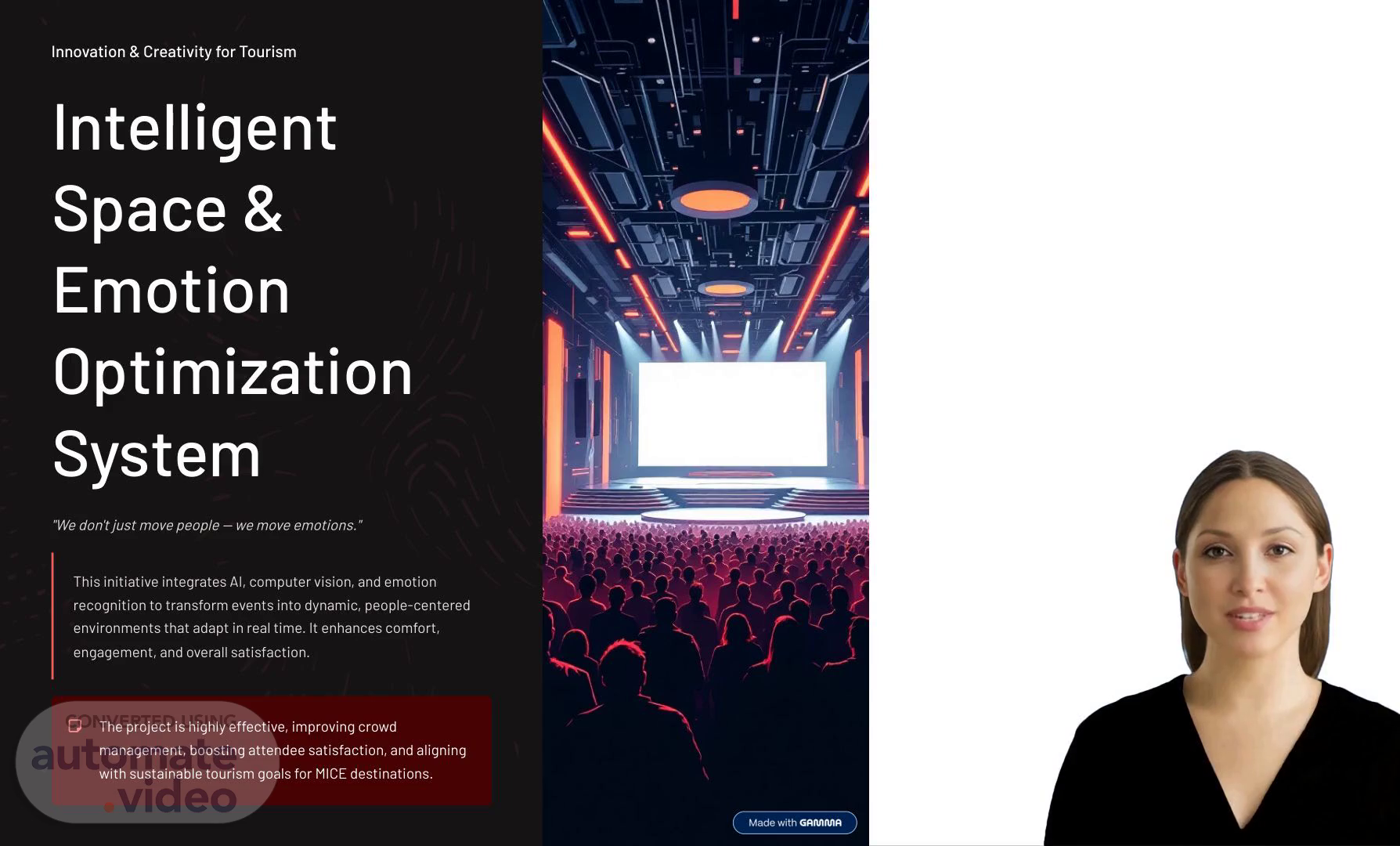Scene 1 (0s)
[Virtual Presenter] The company is launching a new technology-based approach to transform events into more engaging and interactive experiences for attendees. This innovative method utilizes artificial intelligence, computer vision, and emotional analysis to create an immersive environment that adapts to the needs of each individual. By incorporating these cutting-edge technologies, the event organizers are able to improve the comfort, engagement, and overall satisfaction of the attendees. The pilot project has demonstrated impressive results, showing significant improvements in crowd management, attendee satisfaction, and alignment with sustainable tourism goals for meeting, incentive, and convention destinations..
Scene 2 (49s)
[Audio] The system uses artificial intelligence to monitor and manage crowds at events. The system consists of five main components: smart cameras, sensors, AI-powered dashboard, crowd density visualization tools, and automated adjustment systems. The AI-powered dashboard analyzes data from the smart cameras and sensors to provide real-time crowd movement and facial recognition. The system also provides instant, actionable advice for managing crowds and improving the overall event experience. The automated adjustment systems make adjustments to digital signs, lighting, and other elements of the event space based on crowd mood and emotional states. The system also creates personalized digital memories for each attendee, including a short video compiling their photos, event path, and highlights of movement. Attendees receive personalized messages about their happiest moments. The system helps event organizers to better understand the needs and preferences of their attendees..
Scene 3 (2m 0s)
[Audio] The benefits of this system are numerous. For key stakeholders such as organizers, exhibitors, and attendees, it provides enhanced decision-making capabilities. They can make informed decisions by gaining real-time insights into crowd flow and collective emotional states. This allows them to adapt and respond quickly to changes in the environment. The system also promotes event brand sustainability by optimizing lighting and climate control. This results in reduced energy consumption and a more efficient use of resources. Additionally, the system creates unique and sensitive environments that cater to the needs of all participants..
Scene 4 (2m 43s)
[Audio] The use of AI in museums has been a topic of discussion among museum professionals and researchers. Many museums have started to incorporate AI into their collections management systems, but there are concerns about the potential risks associated with its use. One major concern is the privacy of visitors who may unknowingly provide personal data through digital exhibits or interactive displays. The lack of transparency in AI decision-making processes can lead to biased outcomes, which can negatively impact the overall experience of visitors. Moreover, the misuse of AI-powered tools can result in the manipulation of visitor behavior, undermining the integrity of the museum's mission. To mitigate these risks, museums need to prioritize transparency and accountability in their AI-driven initiatives..
Scene 5 (3m 40s)
[Audio] The system combines computer vision, AI, and merging technology to create a dynamic narrative that incorporates affective analysis tools. This approach extends beyond the artistic dimension to analyze data, including lighting, music, and signage. The system also manages the emotional climate by evolving according to the audience's behavior and climate. It redefines the relationship between people and space by adapting to their mood..
Scene 6 (4m 10s)
[Audio] The prototypes demonstrate how the system's interface can be visualized in a physical space, effectively integrating spatial and emotional data. This enables real-time event optimization by providing a more immersive and engaging experience for attendees. The design incorporates various elements such as lighting, sound, and signage to create a cohesive atmosphere. By analyzing these factors, the system can adjust its settings in response to changing environmental conditions, ensuring a seamless and enjoyable experience for all participants. This approach allows for a more personalized and adaptive environment, catering to individual preferences and moods. As a result, the system can optimize event outcomes, leading to increased attendee satisfaction and improved overall quality of the event..
Scene 7 (5m 6s)
[Audio] The Intelligent Space & Emotion Optimization System has been designed to create a more immersive and engaging experience for attendees by utilizing AI-driven adjustments to optimize the environment and flow to ensure higher levels of satisfaction and emotional connection. This system prioritizes ethical innovation, ensuring that all data collected is anonymous and non-discriminatory. Its commitment to transparency and privacy helps build trust among attendees. As a result, this system has the potential to revolutionize the way events are managed and experienced. The system's ability to analyze and respond to attendee emotions and needs in real-time enables it to provide personalized experiences tailored to individual preferences. Furthermore, its capacity to continuously learn from feedback and adapt to changing environments ensures that the experience remains fresh and engaging throughout the event. By leveraging advanced technologies such as machine learning and natural language processing, the system can identify patterns and trends in attendee behavior, allowing for data-driven decision making and optimized event outcomes. The system's focus on creating a positive emotional experience is reflected in its emphasis on comfort, accessibility, and inclusivity. Ultimately, the Intelligent Space & Emotion Optimization System has the power to transform the way we interact with events, fostering a culture of empathy and understanding..
